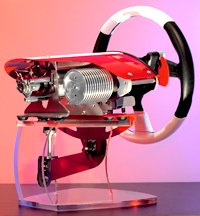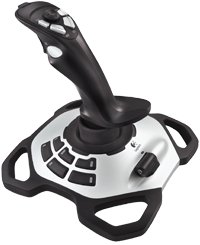Control issues
How to keep your PC Cessna flying straight and your virtual Ferrari on the black stuff

Dear SimColumnist: What kind of steering wheel (or joystick) should I use?
I hear it all the time, especially from racing- or flight-sim newcomers intimidated by some perceived necessity for an expensive top-of-the-line controller. Well, I’ve managed to muddle through the past couple of decades with a variety of sticks, wheels, and other bits of simming hardware, and this month I’ll impart my accumulated wisdom (such as it is) on the subject.
Price Be Damned!
If you have the money, then by all means, go nuts. Some amazing products out there can completely transform your driving and flying experience. PC racers with a spare grand or two have the most choices—between Extreme Competition Control’s and Cannon Simulation Technology’s homegrown lines of metal wheels and pedals, and a burgeoning influx of high-end European driving peripherals from companies like Ball Racing Developments (Google them), you can now create a virtual cockpit that rivals a professional F1 team simulator setup.

Left:ECCI's $1,300 all-metal Trackstar 6000 GTS fluid-damped steering wheel is one of the finest PC driving peripherals money can buy
Apart from a handful of eccentrics with mocked-up F-16 cockpits in their basements, elaborate flight-sim setups aren’t nearly as common. The $300 Thrustmaster HOTAS Cougar still ranks as the gold standard for consumer flightsticks; mate it to a good set of rudder pedals and you’re unlikely to find a better desktop launching pad for your PC flights of fancy.
I Can’t Afford the Entire Paycheck
If a $500–$1,500 investment isn’t in the cards, don’t fret. For less than $400, you can forgo that heavy metal controller package for some exceptional plastic peripherals. On the driving front, the current polesitters are Logitech’s $300 G25 Racing Wheel and Fanatec’s $350 Porsche 911 Turbo Wheel (PCG score: 90%). Both provide excellent force-feedback effects, 900-degree rotation, gated shifters, and ergonomic clutch-equipped pedal boxes mated to digit-caressing hand-stitched leather steering wheels.
Looking skyward, the flight-sim community has enthusiastically embraced CH Products’ impressive catalog of $100–$150 flightsticks, throttles, and rudder pedals for their quality, fidelity, and cast-iron durability. Civvie pilots will also do well with Saitek’s $150 Flight Yoke and Throttle Quadrant, and just about any combat jock I know would perform loops for Saitek’s $200 X52 Pro Flight System.
Sorry, Dude, No Cash
Guess what, folks. The trick to mastering a modern racing or flight sim isn’t in the wheel or the flightstick…it’s in the touch. Just as Tiger Woods can use a cheap set of garage sale golf clubs to annihilate an opponent, anyone reading this column can break track records in GTR2 or dogfight an enemy Messerschmitt into the ground in IL-2 Sturmovik with a decent $50 joystick. For one of those, you need look no further than Saitek.com (six models under $70) or Logitech.com (four sub-$70 models).

Right: In the right hands, any solidly built joystick - like this $30 Logitech Extreme 3D Pro - can get you around the track just as quickly as the high-priced products
I’ll admit to a secret here. Although I own an impressive collection of controllers—including many of the products I’ve just described—I don’t use any of them on a daily basis. In fact, unless I’m reviewing a new game and methodically benchmarking its force-feedback support and controller compatibility, I’ll usually just grab my aging Microsoft Sidewinder Precision Pro twist-axis joystick (complete with an antique gameport-to-USB adaptor).
I bought it for $50 over eight years ago and I’ve logged thousands of track and air miles with it since. It takes up very little desk space, works well with everything I throw at it, and delivers all of the precise analog control necessary to tame a demanding flight or racing sim.
And in the end, that’s all you really need.
August 14, 2008
Sign up to the GamesRadar+ Newsletter
Weekly digests, tales from the communities you love, and more


